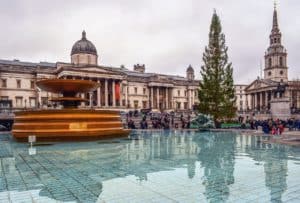Exploring the Rich History of Fort McHenry

Updated On: February 19, 2024 by Esraa Mahmoud
Imagine standing where history roared, the echoes of cannons thundering across the Chesapeake Bay. The Star-Spangled Banner still flutters proudly, a testament to a defiant stand against overwhelming odds.
Welcome to Fort McHenry, America’s guardian, a silent sentinel steeped in stories waiting to be unravelled. More than just a fort, it’s a time capsule where the echoes of the War of 1812 linger, where the ink of the Star-Spangled Banner still seems fresh, and where the spirit of American resilience forever burns bright.
Curious about the epic battle that inspired a national anthem? Want to walk the ramparts where soldiers bravely defended their young nation? Wondering if you can still see the flag that “through the perilous fight, our nation’s hope defied”? Dive into the captivating history of Fort McHenry, where every brick whispers a tale, and every stone bears witness to a pivotal moment in America’s journey.
So, buckle up, history buffs and adventure seekers alike, because we’re about to embark on a voyage through time, exploring the secrets, battles, and enduring legacy of this iconic landmark. From hidden tunnels to the Star-Spangled Banner’s birthplace, get ready to discover the soul of Fort McHenry, a place where history isn’t just a story; it’s an experience waiting to be lived.
History of Fort McHenry
Fort McHenry’s tale isn’t just about a single heroic moment; it’s a woven tapestry of strategic foresight, wartime bravery, and enduring legacy. The year is 1794, and tensions with Great Britain simmer. Recognizing the vulnerability of Baltimore, a crucial port city, President George Washington commissioned the construction of several forts.
Enter John McHenry, a prominent physician and Secretary of War, whose namesake fort would become a symbol of American defiance. Construction began in 1798, utilizing innovative pentagonal design and cutting-edge weaponry, making it one of the most formidable coastal defences of its time.
Though initially intended for the Quasi-War with France, Fort McHenry’s true test came during the War of 1812. With increased British aggression, the fort underwent rapid expansion, its armament bolstered with powerful cannons and mortars. Josiah Dorsey, a skilled engineer, oversaw these crucial modifications, ensuring the fort remained a formidable guardian of Baltimore throughout the conflict.
By September 1814, British forces set their sights on Baltimore, aiming to cripple the young nation’s economic and military might. Fort McHenry stood as the city’s last line of defence. For 25 gruelling hours, the fort endured a relentless bombardment, with over 2,000 shells raining down on its ramparts. Yet, under the courageous leadership of Major George Armistead, the American flag continued to fly proudly, serving as a beacon of hope and defiance.
The Epic Battle of Baltimore & the Star-Spangled Banner’s Birth
The Battle of Baltimore was not just a military clash; it was a crucible where American resilience was forged, and a single symbol defied unimaginable odds.
13 September 1814 dawned with a grim promise. British warships amassed off the coast, their cannons aimed at Fort McHenry. The bombardment began at dawn, a relentless barrage of shells raining down on the fort. The defenders, outnumbered and outgunned, fought valiantly, returning fire with every available cannon. Smoke filled the air, the ground trembled with each explosion, and the fate of Baltimore hung in the balance.
Witnessing the battle from a nearby ship was Francis Scott Key, a lawyer and amateur poet. As the night fell, the bombardment intensified, and Key watched anxiously, unsure of the fort’s fate. Then, at daybreak, a sight filled him with awe: the American flag, tattered but unbroken, still proudly flying over the smoke-filled fort. Inspired by this symbol of resilience, Key penned a poem, “Defence of Fort M’Henry,” later set to music and known as the Star-Spangled Banner.
Key’s poem resonated with the American spirit, capturing the emotions of a nation facing adversity. Its powerful imagery of the flag “through the perilous fight, our nation’s hope defied” became a rallying cry for unity and patriotism. The Star-Spangled Banner quickly gained popularity, eventually becoming the official national anthem in 1931.
The legacy of the Battle of Baltimore extends far beyond the Star-Spangled Banner. It stands as a testament to the courage and determination of the American defenders, reminding us of the sacrifices made to preserve our nation’s freedom. Stay tuned as we explore Fort McHenry’s post-war journey and its enduring significance in the next section!
Beyond the Battleground: Fort McHenry’s Enduring Legacy
As the embers of the War of 1812 faded, Fort McHenry transitioned from active military service to a coastal defence facility. Throughout the 19th and early 20th centuries, it witnessed advancements in weaponry and technology, evolving alongside the nation’s defence needs. Recognizing its historical significance, Congress declared Fort McHenry a National Historic Site in 1925, initiating efforts to preserve and interpret its rich past.
Today, Fort McHenry stands as a vibrant museum and living history space. Visitors can wander its ramparts, explore reconstructed soldiers’ quarters, and delve into exhibits showcasing the fort’s evolution through various eras.
Guided tours bring history to life, with costumed interpreters re-enacting pivotal moments and sharing captivating stories of the fort’s past. Hidden gems like the Flag Bastion, where the Star-Spangled Banner soared, and the Defenders’ Tunnel, offering a glimpse into wartime strategies, add an air of intrigue and authenticity.
Exploring Fort McHenry
At Fort McHenry, there are plenty of outdoor activities and events to enjoy. You can take a stroll or go for a run along the walking, running, and biking path that surrounds the fort.
Step onto the very ground where soldiers defended their nation, their footsteps echoing through reconstructed barracks and guardhouses. Imagine the roar of cannons, the smoke of battle, and the unwavering courage that inspired a nation. The grounds are free to access, so you can explore at your own pace. If you visit during the summer months, you might be lucky enough to witness flag changes and ranger talks that give insight into the fort’s history.
Delve deeper with expert guides who bring history to life. Hear captivating tales of the War of 1812, the birth of the Star-Spangled Banner, and the fort’s evolution through the centuries. Choose from themed tours focusing on specific aspects like military life or the role of women in wartime.
Engage with the past through interactive exhibits showcasing artefacts, maps, and multimedia presentations. Explore the fort’s changing weaponry, learn about daily life for soldiers, and witness the evolution of warfare through the ages.
Stand where the iconic Star-Spangled Banner defied the bombardment, its image forever etched in American memory. Feel the weight of history as you gaze upon the very spot that inspired a nation.
Throughout the year, there are also special events held at Fort McHenry, such as re-enactments and concerts. So whether you’re looking to immerse yourself in history or simply enjoy some fresh air in a beautiful setting, Fort McHenry has something for everyone.
Nearby Attractions
Fort McHenry National Monument and Historic Shrine is a must-see for any history buff visiting Baltimore. But there’s more to see and do in the area than just the fort itself. Here are a few nearby attractions that you won’t want to miss:
- The Baltimore Museum of Art: Home to a world-class collection of art, from ancient Egyptian artefacts to contemporary masterpieces, the Baltimore Museum of Art is a must-see for any art lover. Highlights of the collection include works by Monet, Renoir, Matisse, and Picasso. The museum also offers a variety of special exhibitions and events throughout the year.
- The National Aquarium: Explore the wonders of the deep at the National Aquarium, home to over 20,000 animals from around the world. See sharks, dolphins, sea turtles, and more in immersive exhibits that recreate their natural habitats. The aquarium also offers a variety of educational programs and animal encounters.
- The Walters Art Museum: The Walters Art Museum houses an impressive collection of art from around the world, spanning centuries and cultures. Highlights of the collection include Egyptian mummies, Roman sarcophagi, medieval tapestries, and Renaissance paintings. The museum also offers a variety of special exhibitions and events throughout the year.
- The Maryland Science Center: The Maryland Science Center is a great place to learn about science and technology in a fun and interactive way. The centre features exhibits on everything from dinosaurs to space exploration. There’s also an IMAX theatre and a planetarium.
- The Inner Harbour: The Inner Harbor is a popular destination for locals and tourists alike. There are plenty of shops, restaurants, and attractions to explore, including Harbour Place, the Maryland Science Center, and the National Aquarium. You can also take a ride on a boat or kayak to see the harbour from a different perspective.
In conclusion, Fort McHenry is a fascinating historical site with a rich and storied past. From its construction in the 18th century to its role in the War of 1812, this American coastal fort has played an important role in our nation’s history. Today, visitors can explore the fort’s grounds, learn about its significance at the visitor and education centre, and witness flag changes that commemorate its patriotic heritage. Whether you’re a history buff or simply want to experience warm patriotism and beautiful views, Fort McHenry is definitely worth a visit.






